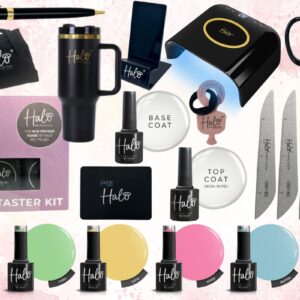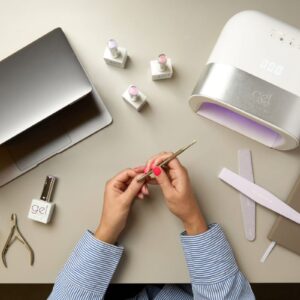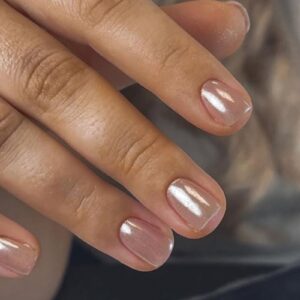
Chrome pigments: a nail expert shares a troubleshooting guide
By Katie Barnes | 06 April 2025 | Expert Advice, Feature, Technique

Educator & award-winning nail pro, Katie Clark, offers advice for dealing with issues that can arise when using chrome pigments…
The chrome nail trend is ever-popular, but are you applying chrome products correctly? Each brand may have slightly different instructions, so always follow these and get in touch with the manufacturer about any queries.
Chipping & peeling
Less is more when it comes to chrome powder, and a little goes a long way. When you apply it to the nail, do so sparsely and firmly, polishing it in until you achieve a mirror-like effect. When you begin to achieve the look you want, turn your applicator or brush to its clean side and buff for a little longer. If the chrome powder goes on too thick, it will leave sparkly particles. This excess product can prevent a thorough cure, which can cause chipping or peeling. Use a soft fluffy brush to dust off any excess.
It is paramount to cap the free edge to ensure you are encasing the chrome pigment sufficiently, otherwise the nail could be prone to chipping. If you aren’t sure how well you are applying top coat, be safe and apply two layers.
Chrome not adhering
Once you have applied non-wipe top coat over your colour of choice, do not touch the surface. Even though it is a non-tacky surface, you can transfer oils from your skin, which may affect adhesion.
If you over-cure the top coat which the chrome is being applied onto, the chrome pigment will often rub straight off. Always follow the manufacturer’s instructions on cure times.
No mirror-like effect
Chrome must be applied over a cured layer of non-wipe top coat. If applied directly onto a colour or tacky layer, a mirror-like effect won’t be achieved. If the top coat isn’t sufficiently cured (quite commonly on the thumbnails if the client hasn’t positioned these correctly), you will experience this issue.
Choose a high-quality, highly pigmented chrome with the smallest micron size and fewest fillers to achieve the best effect. Just as glitter must be cosmetic grade, so must chrome. A good quality chrome pigment will not blend or bleed the powder.
Top coat issues
Pitting, dents or wrinkling in your top coat or chrome occur when the top coat is contaminated with chrome pigment or other containments. If you have a top coat specifically for chrome and it is running low, it may be too contaminated. It is paramount to wipe the top coat brush clean on a soft wipe or tissue after it has touched chrome, before you put it back in the bottle.
Happy chroming!
Love Katie x
*Originally published in 2018

Read the latest issue









